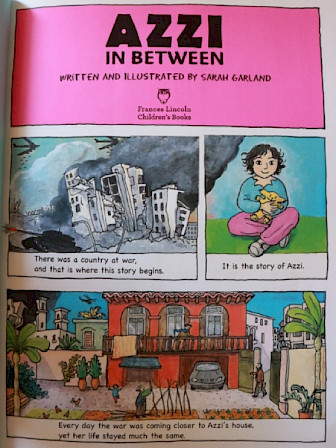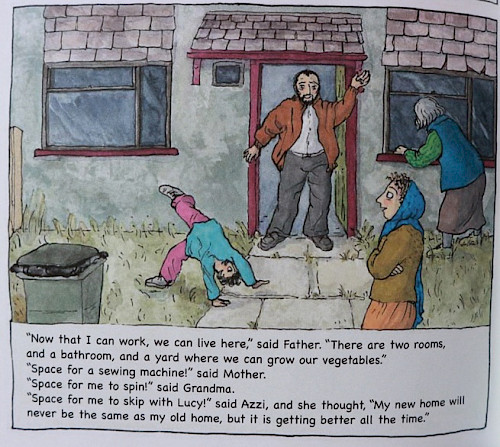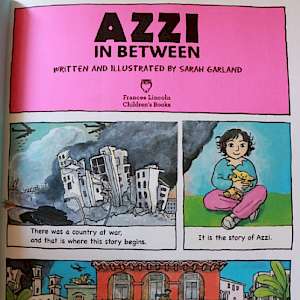This blogpost, by Barbara Katharina Reschenhofer, explores the depiction of child refugee experiences and concepts of 'home' within picturebooks:
When I first started my PhD, I made the decision to study multimodal refugee narratives, because these texts, at first glance, appeared to portray highly complex issues in a simplified way for young readers. However, the deeper I delve into my research, the more apparent it becomes that picturebooks are by no means simplistic. Through the art of multimodal storytelling, these texts manage to cover sensitive subject matters, such as trauma or loss, in finely nuanced ways.
Although each picturebook tells a unique story, I am interested in identifying common patterns and narrative strategies within my selection of primary literature. Not only picturebooks (i.e. texts wherein verbiage and image together construct one multimodal experience) but graphic novels and silent picturebooks, too, use similar strategies to make displacement and flight comprehensible for child readerships. Although I exclusively focus on picturebooks for my PhD project, I am constantly learning more about other multimodal media, featuring refugee child protagonists.
One of the major research questions of my dissertation enquires into the multimodal construction of “home”. Traditionally, children’s literature has constructed home as a domestic safe haven, which stands in direct juxtaposition to the unpredictable and dangerous outside world. However, this rigid idea of home certainly does not apply to every story under the vast umbrella of children’s literature. On the contrary, more and more books for young readers tell stories of war, conflict, broken families, and disrupted childhoods, thus showing that it is time to re-think home as a concept open to interpretation and not necessarily tied to a fixed time or place.
Azzi in Between by Sarah Garland is an excellent example for a young reader’s graphic novel about flight, as it illustrates how home is not necessarily always limited to one spatiality. Like most of the multimodal refugee stories I have come across, Azzi in Between first introduces the protagonist’s home as a house in an unspecified country, which is slowly being consumed by war. Early on in a multimodal refugee story, nature oftentimes plays a large role in constructing a lively and welcoming environment, only for it to then - often still on the very same page - be destroyed by the belligerent forces of war. This clearly is the case on the first page of Azzi in Between: the bottom panel shows precisely this contrast between life and destruction.

In Azzi in Between, the contrast between Azzi’s home and the encroaching war is all too apparent. The house is constructed in warm tones and surrounded by potted plants, palm trees, and patches of soil and greenery. However, the harmonious image is disrupted by a grey cloud of smoke, entering the panel from the left upper corner. Also, the overall composition of the illustration suggests a previously stable life gown awry: The idyllic family home is not placed right at the center of the panel but slightly closer to the right-hand side of the page. It is almost as though the approaching war is slowly but surely pushing the house out of the center. The verbiage, “Every day the war was coming closer to Azzi’s house, yet her life stayed much the same” (Garland 2012), directly reflects this gradual intrusion of war into Azzi’s everyday life.

From this example alone, we can see that subtle details, such as the slightly de-centered placement of a house, can have an immense potential of semantic expression. Though most readers, young or grown, may not necessarily even be aware of such minute details, the multimodal construction of this literal shift in the protagonist’s home life subliminally sets the tone for the rest of the graphic novel.
Just like the visual construction of greenery helps paint a picture of a wholesome home life in the beginning, nature plays a significant role toward the ending of Azzi in Between as well. As they settle into a new country after a tumultuous journey of flight, Azzi surprises her family by planting some of the beans they had brought along on their journey. By growing a bean stock of her own, Azzi brings a sense of familiarity to an entirely new environment. A part of her old home virtually becomes one with her new life, as the familiar, old beans grow in the strange, new soil. The symbolic power of plants growing in a place that should become Azzi’s new home is striking, as the beans help the protagonist bridge the gap between her old life and a fresh beginning. The beans not only symbolize growth and life, they also stand for survival, perseverance, and adaptation.
What is important to note, however, is that the protagonist explicitly states that the new home will never replace her original one: “’My new home will never be the same as my old home, but it is getting better all the time’” (Garland 2012). Nevertheless, by bringing an element of her old home into what represents a sort of new home, Azzi manages to savor an important sense of belonging, identity, and memory. Instead of simply replacing the old with the new, the idea of home is extended rather than changed completely. The bean stock transgresses borders and perseveres, despite severe change - just like Azzi and her family.

Azzi in Between is one of many highly interesting multimodal refugee stories for children, as it is rich in metaphors and strategies which make flight comprehensible for young audiences. From the compositional placement of a house to the use of nature as a symbol for identity and growth, this graphic novel beautifully illustrates how multimodal choices can impact the overall story and help the reader understand what “home” can mean to different people in different contexts. Identifying and making sense of such subtleties in a text is what fascinates me about studying multimodal children’s literature. It is often those texts which appear least complex at first glance which turn out to grow richer in detail, strategic design, and compositional choices with every turn of a page.

